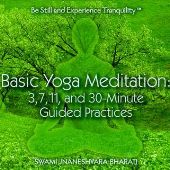|
|
Who's
Driving
your Chariot?
A Question for Yoga
Meditation Practitioners
by
Swami Jnaneshvara Bharati
SwamiJ.com


Symbol of our inner
instruments: The chariot is used by the ancient Yoga sages as a
symbol for how to train your mind and senses. Though most of us do not
use horse drawn chariots, the lesson is as practical today for Yoga as
it was thousands of years ago. Allow your mind to visualize this image,
and it will become a wonderful tool in your Yoga practices and daily
spiritual life.
|
How
to drive your chariot |
| Roads |
The many roads down
which the chariot may travel are the countless objects of desire
in the world and our memory. |
| Horses |
The ten horses are
the ten senses (indriyas) through
which we relate to the external world by perception and action. |
| Reins |
The reins are the
mind (manas) through
which the senses receive their instructions to act and perceive. |
| Charioteer |
The charioteer is
the higher intellect (buddhi),
which is supposed to be the wise giver of instructions to the
mind. |
| Passenger |
The passenger is the
Self, the Atman, the pure center
of consciousness, which is always the neutral witness. |
| Chariot |
The chariot itself
is the physical body, the instrument through which the Self,
intellect, mind, and senses operate. |
Who's driving your
chariot?: For many of us, much of the time, the charioteer is not on
duty. The reins called mind are flapping around freely without the
proper guidance of our inner wisdom. When the reins are free, they give
no instructions to the horses called senses. The horses (senses)
roam freely down any road they feel pulled towards in the moment, in
response to their memories of the past (chitta).
The chariot (body) takes a beating, the horses (senses)
get tired, the reins (mind)
get frayed, and the charioteer (intelligence)
gets lazy. The passenger is completely ignored.
Put the charioteer back
on the job: The solution to the problem is to retrain the charioteer
(intelligence) to pick up the
reins (mind) and start giving
some direction to the horses (senses). This
training is called sadhana, or spiritual practices. It means training
all of the levels of ourselves so that we might experience the still,
silent, eternal center.
Allow the charioteer to
serve the passenger: As the charioteer (intelligence)
becomes more stabilized in being back on the job, there is an ever
increasing awareness of the fact the the entire purpose of the chariot,
horses, reins, and charioteer, are to serve as instruments for the
passenger, the true Self.
Home
Top
-------
This site is devoted to
presenting the ancient Self-Realization path of
the Tradition of the Himalayan masters
in simple, understandable and beneficial ways, while not compromising
quality or depth. The goal of our sadhana or practices is the highest
Joy that comes from the Realization in direct experience of the
center of consciousness, the Self, the Atman or Purusha, which is
one and the same with the Absolute Reality.
This Self-Realization comes through Yoga meditation of the Yoga
Sutras, the contemplative insight of Advaita Vedanta, and the
intense devotion of Samaya Sri Vidya Tantra, the three of which
complement one another like fingers on a hand.
We employ the classical approaches of Raja, Jnana, Karma, and Bhakti
Yoga, as well as Hatha, Kriya, Kundalini, Laya, Mantra, Nada, Siddha,
and Tantra Yoga. Meditation, contemplation, mantra and prayer
finally converge into a unified force directed towards the final
stage, piercing the pearl of wisdom called bindu, leading to the
Absolute.
|
|

